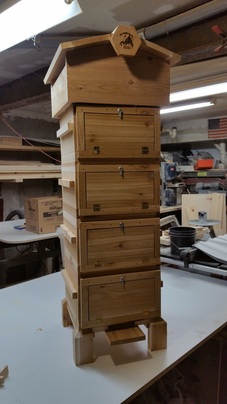So this is the Warre

The Warré (pronounced war-ray) beehive is not very commonly used today, but has experienced a resurgence in popularity among hobbyist beekeepers and those who would like to manage a hive with minimal inspections and without using foundation. It was developed by a French pastor, Emile Warré, about one hundred years ago. Warré called his hive the "People's Hive." It was meant to be simple and bee-friendly as well as help overwinter bees in colder climates.
Features of the Warré Hive Design
- Hive bodies are square and smaller than a Langstroth hive.
- Most Warré hives do not use frames, only top bars. The bees build wax comb without foundation off the top bars. The sides of the comb are attached to the interior walls of the hives.
- A "quilt" filled with sawdust rests on the upper hive body. The quilt absorbs excess hive moisture and provides insulation.
- The roof is sloped and vented to allow for ventilation.
- The entrance is sized for most situations and usually does not need to be modified.
Proponents of Warré hive design like that the size and shape of the hive is more natural for the bees. It is more like their natural home: a cavity in the trunk of a tree. Bees typically build downward, beginning by constructing comb that attaches to the cavity ceiling. Bees raise brood in this upper part of the hive at first, but as the hive expands, the brood are kept lower down, and the upper area is used for honey storage. As winter approaches, the bees cluster in the lower part of the nest with honey stored above them. As the winter progresses, they move upward as they consume the honey stores.
Because Langstroth hives are larger, there are often problems with bees accessing the honey stored on the sides of the cluster, on frames on either end of the boxes. Bees may starve with honey stores to either side of them! Warre felt that 300 mm (or just under 12 inches) square was the ideal inside dimension for the bee cluster to get through winter being able to move straight upward through the stores. Since in a Warré hive, the bee cluster is almost touching the hive walls, there is little to no condensation in the corners. Condensation occurs in Langstroth hives, and can contribute to winter diseases like nosema as well as mold and mildew. The Warre hive's quilt and roof combination also allows for a more natural style of ventilation while still insulating the hive. Warré's idea was that the quilt mimics the top of the tree cavity - decomposing, soft wood that allows moisture to escape without condensation.
Warré Hive Management
Warré hives are managed in a slightly different way from Langstroth hives. The key is that they require very little intervention from the beekeeper. Instead of adding boxes to the top of the hive, in a Warré hive the beekeeper adds hive bodies under the existing brood chamber, mimicking the way bees naturally move in a tree. The brood nest will be moved down into the new wax and the upper area is used for honey storage. Since Warré hives are smaller than Langstroth boxes, you will need to leave at least two, possibly three, hive bodies to overwinter your colony. Typically, in the spring, you will add two hive bodies to the bottom of the Warré hive. You may have to add another hive body if the summer nectar flow is strong - this can be done underneath the existing or above (supering).
Harvesting Honey in a Warré Hive
Just like in a Langstroth hive design, you will need to suit up and get your smoker going when it's time to harvest honey. Remove the top hive body and inspect your hive, leaving the bulk of the brood chamber and at least one hive body above it that is mostly full of honey for them for winter. You can leave them uncapped honey but any harvested honey must be capped, as uncapped honey will ferment. After deciding which boxes are for harvest, use a bee escape board. Place the board in the hive and place the honey boxes above it. Reinstall the top of the hive, then wait around 24 hours for all the bees to leave the honey boxes. Open up the hive and remove the honey boxes for harvesting as well as the bee escape board. That's all there is to it!